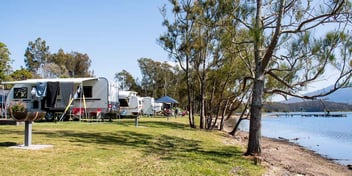New operations deliver cleaner, safer water to MidCoast Council region
Water and wastewater services at NSW’s MidCoast Council underwent significant operational changes following a reorganisation, which offered opportunities for realigning processes to increase public health outcomes for the community.
By using change management principles — specifically the ADKAR (Awareness, Desire, Knowledge, Ability and Reinforcement) Change Management Model — the MidCoast Council underwent operations reviews to identify areas of public health risk following the transition.
Speaking on the Ozwater’20 Podcast series Contaminants of Concern, NSW MidCoast Council Water Quality Team Coordinator Lisa Andersons said one of the areas the team focused on was reducing the water-sewer cross-contamination risk present due to staffing requirements.
“As a council, we were in the middle of a lot of big changes. Previously, we were a standalone water utility and then we were merged into a general purpose council. There was a lot of change going on in all of our areas of operation, as well as our day-to-day work,” Andersons said.
“We wanted to use an approach that would make sure the changes were accepted and sustainable in the long term, and we thought ADKAR focused on each individual aspect well.
“We spent a lot of time on our catchment and then on our water treatment plan. We also did some work on reservoir integrity and backflow prevention. The next logical step was to look at network integrity and recontamination risks, particularly around water mains repairs.”
Andersons said one of the primary focuses was to consider how operations teams working across both water and sewer operations could better align working practices with hygiene standards.
“Our crews work in both water and sewer; we have one set of tools, boots and trucks that service both areas. It wasn’t really possible for us to split up roles into separate water and sewer categories,” she said.
“We had a Safe Work method statement, but there was no focus specifically on hygiene. There was also no guidance on water quality targets, how long we needed to flush for or what our disinfection options were.
“We needed to come up with a way of stopping cross contamination from sewer to water. Changing tools, workwear, including protective gear, and making sure that everything is kept in a condition to promote hygiene were some of the key changes we needed to implement.”
In order to implement changes that would be integrated into working practices effectively, Andersons said the Council took a personal responsibility approach to help drive home the importance of ensuring newly introduced procedures were maintained into the future.
“We wanted to create a real sense of personal responsibility. Our community drinks the water, and so do our crews, but we took it one step further and came up with a scenario around schools,” she said.
“How would the crew and the community feel about contamination entering the water at the school due to a job that was rushed or not completed effectively?”
New standards
The change management process adopted by Council also included training, which Andersons said was a crucial element of introducing and maintaining new operations standards.
“We wanted to make sure we had a trainer that was both knowledgeable and trusted. Someone our organisation had worked with previously, but also someone that wouldn't be seen as a technical manager without hands on experience,” she said.
“Having a trusted trainer was a really big part of the success, as well as involving the right people at the right time. This included representatives from NSW Health and the Department of Industry and Environment, as well as our director, managers and coordinators.”
With ability and reinforcement being important change management principles, Andersons said the focus was to ensure sustainability of staff ability. Furthermore, reinforcement required ensuring staff support was accessible and transparent.
“We wanted to make sure we were developing the ability for our staff to participate in these activities long term. We focused on hands-on training of the water quality monitoring equipment that the crews now use out in the field,” she said.
“As far as reinforcement goes, it’s one of the most important steps in change management and is often forgotten. But if you don’t have that ongoing reinforcement then there is a high chance that the program won’t succeed long term.
“We made sure we support staff in an ongoing way to make sure the changes last. This includes refresher training, ensuring access to subject matter experts, being available if someone is in the field conducting a main break repair and they need assistance.
“It’s also important to highlight and celebrate success to make sure people are aware that what they are doing is working and is benefiting the public by reducing risk.”
Clean outcome
Andersons said the change management principles have proven successful, with the Council yet to record a contamination event since implementation.
“Every single test that we have done after the new processes for water main repairs have been in place have come up clear. We have had no E.Coli detected on any of the samples following the process. We are very happy with the outcome,” she said.
“You can’t underestimate the importance of change management drivers. It was not just about the water hygiene side of the project, it was also about the way we manage change.”
To hear more from water experts on managing contaminants, take a look at the other AWA Podcasts in the Contaminants of Concern series.
[embed]https://omny.fm/shows/australianwater/lisa-andersons-on-managing-contamination-risks[/embed]

